To meet domestic and export demand for the SUVs it produces, BMW is introducing measures to reduce logistics cost and complexity at its Spartanburg plant.
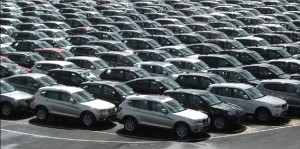 BMW’s only North American factory, located in Greer, South Carolina close to Spartanburg, has become one of its most important production centres anywhere in the world. Not only does it help meet fast-growing demand in the US and North American market, there is also global demand for the SUVs – or ‘Sport Activity Vehicles’, as BMW calls them – which are produced at the plant. The $2.2 billion assembly facility, which employs 8,000 people, is the only BMW plant producing the series X3 and X5 Sports Activity Vehicles and the X6 Sports Activity Coupe. Next year, the plant is also slated to start assembling the new X4, with a round of investment that will eventually increase capacity from 300,000 annual units to 350,000.
BMW’s only North American factory, located in Greer, South Carolina close to Spartanburg, has become one of its most important production centres anywhere in the world. Not only does it help meet fast-growing demand in the US and North American market, there is also global demand for the SUVs – or ‘Sport Activity Vehicles’, as BMW calls them – which are produced at the plant. The $2.2 billion assembly facility, which employs 8,000 people, is the only BMW plant producing the series X3 and X5 Sports Activity Vehicles and the X6 Sports Activity Coupe. Next year, the plant is also slated to start assembling the new X4, with a round of investment that will eventually increase capacity from 300,000 annual units to 350,000.
In 2012, the Spartanburg plant produced 301,500 vehicles and exported nearly 70% of them to around 150 countries, including large flows to China, Germany, the UK and elsewhere. With exports of around 211,000 vehicles totalling $7.4 billion in sales, BMW is one of the largest vehicle exporters by volume and value in the country. Production this year has been at a similar pace to that of 2012 through November. 
With high volume expected to rise, and with an increasingly global and complex supply chain, logistics effectiveness has become even more important to BMW at Spartanburg, according to Marcus Wollens, vice-president of logistics planning for the BMW Group, who is based at the carmaker’s headquarters in Munich.
BMW, which has a closely integrated management structure for the Spartanburg plant and its central logistics and purchasing teams in Munich, has recently undertaken a number of initiatives to reduce logistics costs and the carbon footprint for production distribution at the plant. For example, the company has recently switched to lower cost rail transport for import drayage from its entry port in Charleston, South Carolina, and has also introduced a new inland container port that speeds up port transfers for imported material. Spartanburg is also the first plant to employ BMW’s new small parts warehousing concept to help improve velocity for its in-plant logistics.
For outbound logistics, the carmaker is also using rail to move its vehicles to the port of Charleston for global exports. It exports Mexico and Canada-bound vehicles from the port by short-sea ro-ro shipping.
North American inbound network
BMW sources or picks up most of the material for the Spartanburg plant in the US as part of a huge trucking network that involves more than 700 trucks per day. For the North America supply chain, Wollens says the company’s priorities are to maintain and improve the quality of its trucking providers in areas such as on-time delivery.
For US suppliers, the average distance to the Spartanburg plant is around 180 miles (290km). A large number of North American suppliers use full truckload (FTL) transport, especially for just-in-time (JIT), just-in-sequence (JIS) and a high volume of what BMW calls ‘direct montage and assembly’ parts (DIMO). The latter are parts delivered directly to the assembly area, but not in sequence and without a definite time stamp for use at the assembly line. Wollens says that JIT, JIS and DIMO parts account for about 80% of Spartanburg’s inbound volume.
Most of the remaining domestic and North American volume is consolidated through warehouses and distribution hubs before arriving at the assembly line. The consolidated logistics network also ships stock parts from across North America.
BMW Spartanburg receives about 740 trucks daily, which consist of 400 JIT/JIS, 300 bulk trucks and 40 sea containers. Its delivery frequency depends on the type of material. For example, JIS deliveries of parts such as seats or bumpers arrive hourly, while stock parts arrive as consolidated freight two or three times a week. Wollens emphasises that BMW aims for a high delivery frequency, but also wants to avoid air freight, which is why it consolidates its shipments. Wollens adds that by focusing on a high fill rate of more than 95%, with a reasonable delivery frequency, BMW can use more direct shipments and avoid using more milkruns.
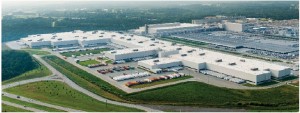
Whether it ships by FTL or by consolidation centres, BMW uses various logistics providers for its inbound services. Such services include transport, but also route planning management and pick-up optimisation for the truck network. The carmaker’s inland port storage is also outsourced. However, BMW contracts directly with all of its logistics providers and does not use third party logistics providers to manage carriers, according to Christoph von Patow, head of logistics planning at BMW Spartanburg. Von Patow adds that BMW handles all its logistics functions with in-house staff, such as sequencing.
Global supply chain management
While the supply chain for the vehicles built at Spartanburg has a strong concentration in North America, a sizeable amount of content is also imported from international and intercontinental sources. In terms of supplier pickup locations, BMW sources more than 90% of its parts from the US, 5% from Europe, 3% from Mexico and 1% from others, such as Canada and China. However, the supply chain’s manufacturing origins reveal a more global mix, as a number of suppliers build their products in Asia and ship to local warehouses in the US. BMW considers these suppliers to be part of its US sourcing and Wollens and Von Patow maintain that such content ranks in the mid-single digits percentage-wise.
As BMW’s production and supplier network grows across the world, Wollens says managing cross-regional and intercontinental supply flows has become more complex. “External sourcing is becoming more globalised. This creates challenges not just with costs, but also with ensuring supplier competency,” he says. “In the past, BMW’s plants were mostly standalone. Now, they may produce as many as eight models per plant. This creates greater complexity and the need for a high degree of flexibility in manufacturing since it increases the number of parts needed line side.”
From Europe, BMW consolidates its material bound for Spartanburg in a variety of pick-up methods. For higher volume equipment, the carmaker uses the ‘sea direct’ method, in which ocean containers are loaded at single supplier locations and move by truck to the port of export. This method, used for commodities such as engines, currently accounts for about 37 containers per day. Small parts and lower volume shipments are picked up by milkrun at suppliers, consolidated into sea containers at a centre in Wackersdorf, then delivered by rail to the port of Bremerhaven, where they are loaded onto ocean carriers. The Wackersdorf consolidation centre currently ships about three containers per day, according to Wollens. The sea containers arrive at the port of Charleston, about 215 miles from the plant.
From Asia, in early 2013 BMW established a direct supply network for both sea and air freight which Wollens says means the Spartanburg plant is now fully integrated into BMW’s global sourcing network.
Wollens expects that the supply chain will become even more complex and globally diverse. “We are sourcing more overseas and from more countries. Our overseas sourcing of 5-7% used to be 99% from Europe and 1% from other countries. Now and as it evolves, our overseas sourcing is about 45% from Europe and 55% from Asia. We are sourcing small parts globally,” reveals Wollens.
As intricate as BMW’s inbound logistics network is, the outbound logistics system from Spartanburg also entails a complex global network, with exports to 150 countries worldwide, according to Mathias Wellbrock, general manager of vehicle dispatch and distribution for the BMW Group. “Approximately 30% of our total volume [from Spartanburg] is destined for Europe and we export about 25% of our total volume to Asia. We export the rest of our overseas volume to South America and Oceania,” he says.
BMW generally expects to move about 20-30% of its production volume to the North American market, with more than 95% of this volume staying in the US. The deliveries to Canada and Mexico move on ro-ro ships.
From Spartanburg, BMW now moves about 70% of its finished vehicles by rail and 30% by truck, with most of the rail headed to the port of Charleston for export. The percentage of rail was relatively stable during the plant’s huge production increase, which has seen output rise from 123,000 units in 2009 to the latest figures of more than 300,000 units.
Among the OEM’s main outbound challenges are capacity peaks and the reallocation of vehicles that need to be covered by the transport provider’s capacity.
“The challenge is limited supplier investment in transport capacity,” says Wellbrock.
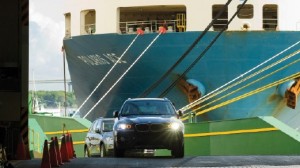
Switching to rail for inland flows
BMW’s inbound logistics network in North America has recently undergone some significant improvements. Chief among them, in late 2013, was a plan to use rail transport for sea containers that arrive at Charleston. The carmaker switched from truck to rail to move the containers to a new customs-bonded, multi-user inland terminal in Greer. The terminal, which is in a designated free trade zone, will handle all customs clearance for BMW’s container imports.
BMW currently reserves 700 container spaces at the Greer terminal. “Our main reason for using the new facility is to get sea containers off the road and store them in the lot. The idea is to maximise storage in the container – not in the plant – by keeping [material] off-site as long as possible,” explains Wollens. “From the Greer terminal, containers are delivered to a dock door either at the assembly area or the inbound logistics centre. The additional space that will become available will enable future growth and development of the Spartanburg plant.”
As well as saving space, BMW expects to achieve an overall cost reduction by storing its import containers at the Greer terminal and calling them out as JIT deliveries.
Wollens says that by the end of 2013, almost all imported containers were scheduled to move by rail, which will help the company reduce CO2 emissions in transport. Only containers that are particularly urgent upon a vessel’s arrival in Charleston will move by truck. Wollens predicts that the latter should account for about 10% of the total. He adds that the Greer terminal will also make it easier for BMW to have visibility of its inbound logistics for receiving, storage, picking and delivery.
Integrating plant and warehouse
BMW’s warehousing strategy in the US is integrated with its IT protocol. Wollens says it uses SAP standards for its entire warehousing and delivery process, including automated call-offs from the assembly line, which trigger trailer call-offs from the yard to replenish stock. BMW’s SAP warehousing system manages all of its storage locations, captures all material and scans it to a defined location.
BMW receives the material, processes it to its defined storage type and location, then maintains it as SAP master data. Wollens says that, based on call-offs, the material is packed in the warehouse either in bulk, piece, or sequence and then handed over to a defined distribution point in the warehouse. Parts are scanned from the material train at the distribution point and then transported line side and scanned for delivery to the individual tact.
BMW relies on real-time tracking and tracing of its shipments. Its IT system provides updated tracking and tracing information as the sea container passes predefined checkpoints that are set up along the vessels’ routes through GPS and satellite signals. Truck drivers use mobile scanner devices on pallets, racks, and boxes to provide information about current activities. The pick-up list is updated with possible changes when the truck driver arrives at the supplier’s location.
Wollens notes that the driver can only scan and pick up the correct parts in the correct quantity. Each driver’s activity is transferred in real time to logistics providers and to BMW, which allows for an immediate reaction in case of a delay or error. The shipment’s ETA is updated automatically and an exception report is generated for the material planner if it exceeds predefined thresholds for standard processing time and safety lead times.

Improving in-plant flows
For its in-plant logistics, BMW has embraced the trend of using small boxes line side. “We are moving more toward designing how parts are delivered to the line side,” says Wollens. “Small boxes hold smaller parts. The concept is about carrying small boxes to the line side efficiently.”
BMW has created this system by implementing a new, fully automated small parts warehouse, which is a roughly 4,200 sq.m attachment to the plant’s existing logistics centre. Wollens says Spartanburg is the first BMW plant to use such a warehouse, which handles a flow of 700 boxes per hour.
“The key advantage of the small parts warehouse is that it reduces the number of manual handling steps from six to just two, thus creating a more efficient materials flow,” says Wollens. “In the entire small parts warehouse process, the boxes and parts are only touched twice – in the receiving process at the depalletising station, and when feeding the flow rack at the assembly line.”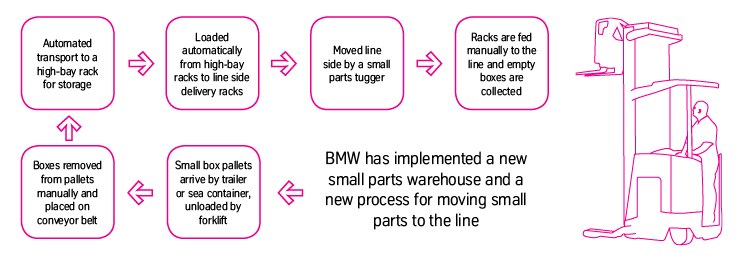
Another of BMW’s objectives is to use just one storage location for each part number within the plant, which would minimise handling. From storage, BMW delivers the part directly line side and does not store it a second time, such as in the assembly area, for example. Furthermore, BMW wants to improve its packaging and labelling quality to avoid the need for repacking and re-labelling. Wollens points out that cardboard packaging from overseas tends to fall apart because of the humidity in sea containers or the lack of careful handling.
“Automated label scanning requires the labels to be in good shape, which is not always the case with overseas packaging,” he adds.
Logistics evolution
BMW is planning to implement a more efficient process for receiving trucks at its plant and a more transparent yard management system that uses RFID and GPS technology. “Within the next year, we will roll out SAP for yard management. At this point, part of our network still uses an old IT system, so we will integrate it more into the SAP system.” says Wollens.
“To be honest, some of our competitors are a bit more advanced in RFID,” admits Wollens.
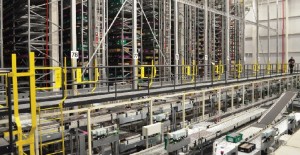
BMW’s plans for automated data collection will facilitate its evaluation of logistics providers’ performance and their adherence to KPIs, which is something the carmaker monitors with vigour. The BMW logistics team provides regular reporting of its KPIs to the logistics providers, along with countermeasures and trend analysis to help them improve.
As it looks to the future, which will include the rollout of a new model in the plant and an increase in production capacity, BMW Spartanburg has plans for increased supply chain transparency that are geared toward improving both inbound and outbound velocity. The recent adaptation of a small box flow was an important step for its in-plant efficiency, while increasing multimodal transport at the same time as increasing JIT and JIS deliveries will increase the plant’s overall productivity. Logistics, it is clear, remains a major focus as BMW increases production for Spartanburg.

























![Global[1]](https://d3n5uof8vony13.cloudfront.net/Pictures/web/a/d/s/global1_726550.svgz)









